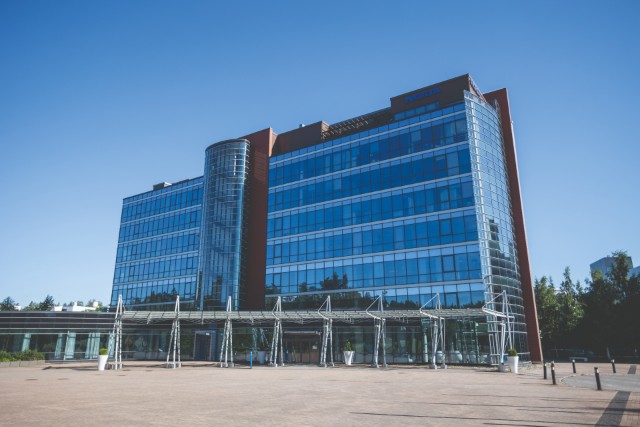Physical Address
304 North Cardinal St.
Dorchester Center, MA 02124
Physical Address
304 North Cardinal St.
Dorchester Center, MA 02124

5G is inspiring a new level of innovation as deployments continue to ramp up.
Not least is the focus on truly sustainable services as the concept of Industry 4.0 takes hold and new services like AI come to the fore.
Many telecoms companies have set out their aims and predictions for the future as the themes of sustainability and full network coverage dominate the industry.
Nokia is one of those companies, with plans to help different parts of society adapt to changing technologies.
For years, the Finnish vendor has been a leader in the technology landscape, delivering networks to address global issues such as climate change, declining productivity and unequal access to digital opportunities.
The company’s European vice president and chief technology officer, Azfar Aslam, believes themes like sustainability and Industry 4.0 will impact the digital landscape this year and beyond, with Nokia aiming to be at the forefront.
The company has committed to reducing emissions by 50 per cent across operations and products in use by 2030 in a bid to be more sustainable.
Speaking to Mobile News, Aslam said Nokia has been making changes across its Scope 1, 2 and 3 greenhouse gas emissions to meet the 2030 target.
“Scope 1 and 2 are about our own emissions,” said Aslam. “It’s an area in which we have been actively improving for many years now through automation of our own solutions, such as building works, electricity buyers, our units, the operational upgrades of buildings, and the facilities and fleet we manage.”
But it is Scope 3 emissions – which refer to indirect emissions across a company’s wider supply chain – that are the largest contributor to emissions, resulting from customers using Nokia’s products in their networks. Indeed, these products account for 90 per cent of the company’s carbon footprint.
Aslam said corporations including Nokia are researching and implementing changes to combat such emissions.
“What we’ve learnt is that every time we put a base station somewhere, or a mobile mast, it consumes energy and the power consumption and cost go up,” he said.
“We’ve been looking at the cost dimension of this for a long time. Now, with the technologies available, we are finding that in the next few years we have the levers to bring down the consumption of telecoms networks significantly.”
Aslam said one of the ways in which Nokia is planning to move ahead on this is by bringing specialised high-performing chipsets into its millions of base stations around the world, helping to avoid replacing base stations and reducing power consumption by 40 to 70 per cent.

Power consumption and CO2 emissions are not the only environmental hazards in the technology industry: waste is another problem as customers move from one set of components to another, such as when switching handsets.
“Over the last few years, what we have been doing is making sure that our products are designed in ways that will help avoid that kind of rip and replace,” said Aslam.
“Longer-life and very high-quality products mean you don’t have to replace the entire base station – you just take a very small component from the next generation of shipments that come. You take the old slot out, pop the new one in, job done.”
He added that durable phones, better software and reusable materials are just some of the ways that Nokia is cutting down on electronic waste.
Fresh innovations in the technology sector can aid companies in becoming more sustainable, digitalised, and advanced, with Aslam believing that the concept of Industry 4.0 will help to achieve this.
Nokia describes Industry 4.0 as using “digitalisation and automation to sustainably source resources, move them to market, manufacture, power, operate and service all aspects of our new, technological world, including the management of our cities and the well-being of people and the planet.”
Aslam explains that the idea of Industry 4.0 started emerging more than a decade ago as a way to aid the catch-up of certain industries with heavy equipment, materials and production lines that missed out on Industry 3.0, known as the ‘digital revolution.’
“The initial objective was the digitalisation of the manufacturing industry, and that was because we wanted to make the industry more competitive with greater productivity,” he said.
From the side of mobile networks, Industry 4.0 is currently largely powered by 4G private wireless networks, but will transition to 5G once demand grows.
This is something that is crucial to accelerate the economy of today, said Aslam.
“In advanced economies like the US, Europe and a few others, the rate of productivity improvement has actually been going down despite the invention of the networks and computers,” he said.
“We are starting to use Industry 4.0 across all industries to begin improving the rate of productivity.
“There are more robotics being brought in and more use of analytics – so wherever you can reduce wastage in the industrial process, we’re working on that at Nokia.
“We are automating that and because we’re learning, we’re taking these capabilities to our industrial customers, whether in the automotive industry, energy, oil, gas or manufacturing of any kind.
“We are making our learnings, equipment and services available to them so that they can evolve and become more productive.”
But there is lots of room for further expansion, with Nokia’s studies suggesting that digitalisation across Europe is roughly a third of what it could be.
Europe was also slightly slow to start its 5G rollout compared to the US and China, with Aslam saying some of the delay was due to the pandemic and that things should pick up now.
“That was in 2020 and 2021, but this year we can build this cycle where the rollout is intensifying, so Europe will catch up compared to some of the advanced regions with 5G,” said Aslam.
“One of the biggest drivers for 5G in Europe is going to be that industrial segment. That industrial deployment will continue for a very long time.
Aslam said that bigger European economies such as the UK, Spain, France, Italy and Germany were early adopters of the technology, but adoption will take different times in different countries.
“You have some countries in Central and Eastern Europe that are a bit behind simply because the regulator didn’t make the spectrum available in time or it was delayed,” he said.
“Some countries wanted to sweat out their 4G services just a bit longer. If I look at countries like Turkey and Russia, they haven’t even started there yet.
“Part of it is to do with the spectrum availability, and part of it is to do with these specific national ambitions and requirements.”

In terms of 5G rollout and connectivity, Aslam is hopeful that the technology will help really improve coverage in rural areas, though that poses its own challenges.
“I think the one thing the entire industry now begins to realise is that there’s no one solution for rural connectivity,” he said.
“So there is a need to roll out fibre in rural areas; that is very expensive because the subscriber densities aren’t as high as in cities like London and the business cases take a long time to pay back.”
But Aslam highlighted that there is a more urgent need to expand this infrastructure in light of the changes that COVID has influenced.
“Everybody realises that hybrid working is going to be here for a while, so all those commuter towns where people were just coming into London need their own infrastructure to be able to sustain it,” he said.
Aslam added that government and European funds are being made available, while there have been movements to get fibre to underserved communities.
Furthermore, he pointed out, neutral hosts are appearing in the form of companies backed by financial institutions that roll out fibre and make it available for everybody who wants to use it.
Some are, however, using alternative options to fill in gaps. “There are a number of countries across Europe delivering fixed wireless access because no matter what, fibre cannot get to certain communities whether the money is available or not,” he said.
5G will help accelerate coverage, says Aslam. “With 5G, we have a bunch of new tools available at our disposal to help us deliver coverage to broader rural communities, and that is from the spectrum we are getting from the government.”
Aslam also says that new antenna technology and lowpower- consumption chipsets can help customers in rural areas better than previous generations of technology.
“When you put all of those things together, we have the perfect storm brewing to finally help customers in rural areas to get broadband services,” he said.
In terms of what could happen in the telecoms industry this year, Aslam believes that openness in networks will become a staple for companies in using technology.
“For example, within Industry 4.0 applications, automation is not going to happen just because you have a robot and you have 5G,” he said.
“There’s a lot of solutions that need to work together, so for the robotics to work well, they need a certain quality of service from the network to talk to the cloud where the applications are sitting.
“For that to happen, we have to open up our equipment, software stacks and hardware so that the enterprise application developers using our APIs can access the right capabilities from the 5G network.”
Openness is important for industries to build their own applications for overall automation, Aslam added.
“Without this, we will not have the ecosystem of all these players working, which means there is no automation,” he said.
“So for the entire premise of automation to be realised, this kind of openness and interworking across different players is really important.”

AI and the metaverse are other themes that Aslam believes could become prevalent in the telecoms sector this year.
“We’re implementing AI in Nokia products and helping other industries realise the benefit of networking and connecting AI algorithms to machines.”
Aslam adds that the metaverse is an exciting topic due to the amount of money being committed to the concept and how industry giants are using it.
“They are starting to create the digital twins of factories, and digital twins are effectively the work equivalent of the metaverse,” he said.
“Connect to a device, and you are inside the digital plant and you can isolate the faults, fix issues and figure out how to best evolve that huge manufacturing plant to next-generation capabilities.”
But Aslam said that for all this to work, new types of devices will need to be in use. “The thing that connects the device to the cloud will be these next-generation 5G networks and optical networks,” he said.
“The exciting part is how we’ll create this for enterprise industrial customers and residential consumers.”
Nokia is working on the metaverse and how it can be made available within its networks, as well as how telecoms providers can sell it directly to consumers, enterprises or those providing the AI version of the metaverse, Aslam added.
“Monetisation is going to happen from these new services because the demand for networks will change dramatically and someone is going to have to pay for it,” he said.
“But the value is absolutely clear already in the industrial setting, so we are big believers and are supporting digital-twin development and enablement through our networks and cloud infrastructure.”